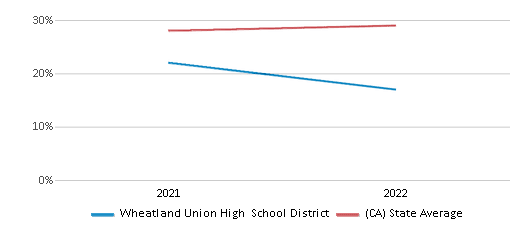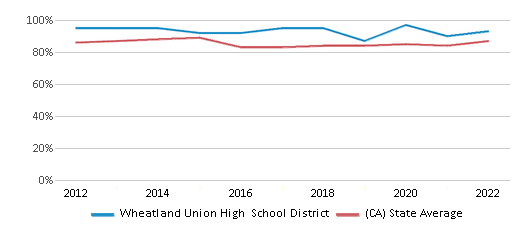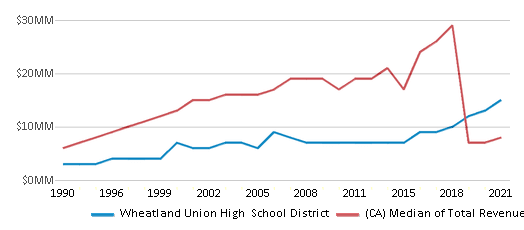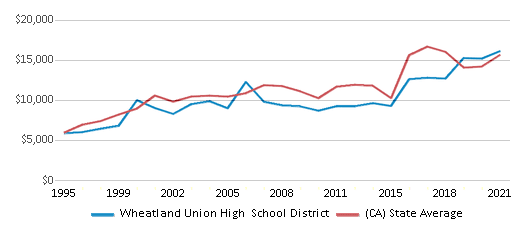Top Rankings
Wheatland Union High School District ranks among the top 20% of public school district in California for:
Category
Attribute
Diversity
Most diverse schools (Top 1%)
For the 2025 school year, there is 1 public middle school serving 5 students in Wheatland Union High School District.
Public Middle Schools in Wheatland Union High School District have a diversity score of 0.65, which is more than the California public middle school average of 0.64.
Minority enrollment is 60% of the student body (majority Hispanic), which is less than the California public middle school average of 78% (majority Hispanic).
Overview
This School District
This State (CA)
# Schools
3 Schools
3,501 Schools
# Students
1,091 Students
1,854,363 Students
# Teachers
53 Teachers
87,821 Teachers
Student : Teacher Ratio
21:1
21:1
District Rank
Wheatland Union High School District, which is ranked #1252 of all 1,925 school districts in California (based off of combined math and reading proficiency testing data) for the 2021-2022 school year.
The school district's graduation rate of 93% has decreased from 95% over five school years.
Overall District Rank
#1283 out of 1941 school districts
(Bottom 50%)
(Bottom 50%)

Math Test Scores (% Proficient)
17%
33%

Reading/Language Arts Test Scores (% Proficient)
38%
47%

Science Test Scores (% Proficient)
15-19%
29%

Graduation Rate
93%
87%

Students by Ethnicity:
Diversity Score
0.70
0.64
# American Indian Students
10 Students
9,887 Students
% American Indian Students
1%
1%
# Asian Students
73 Students
201,760 Students
% Asian Students
7%
11%
# Hispanic Students
368 Students
1,009,980 Students
% Hispanic Students
34%
55%
# Black Students
39 Students
97,908 Students
% Black Students
3%
5%
# White Students
449 Students
413,325 Students
% White Students
41%
22%
# Hawaiian Students
9 Students
7,600 Students
% Hawaiian Students
1%
n/a
# Two or more races Students
141 Students
109,003 Students
% of Two or more races Students
13%
6%
Students by Grade:
# Students in PK Grade:
-
83
# Students in K Grade:
-
90,358
# Students in 1st Grade:
-
70,728
# Students in 2nd Grade:
-
73,359
# Students in 3rd Grade:
-
73,090
# Students in 4th Grade:
-
76,068
# Students in 5th Grade:
-
82,191
# Students in 6th Grade:
-
289,122
# Students in 7th Grade:
-
439,549
# Students in 8th Grade:
-
441,705
# Students in 9th Grade:
260
59,696
# Students in 10th Grade:
278
51,846
# Students in 11th Grade:
259
51,149
# Students in 12th Grade:
294
55,419
# Ungraded Students:
-
-
District Revenue and Spending
The revenue/student of $13,796 in this school district is less than the state median of $19,974. The school district revenue/student has declined by 14% over four school years.
The school district's spending/student of $12,665 is less than the state median of $18,396. The school district spending/student has declined by 14% over four school years.
Total Revenue
$15 MM
$116,387 MM

Spending
$14 MM
$107,188 MM

Revenue / Student
$13,796
$19,974

Spending / Student
$12,665
$18,396

Best Wheatland Union High School District Public Middle Schools (2025)
School
(Math and Reading Proficiency)
(Math and Reading Proficiency)
Location
Grades
Students
Rank: n/an/a
Wheatland Community Day High School
Alternative School
1010 Wheatland Rd.
Wheatland, CA 95692
(530) 633-3100
Wheatland, CA 95692
(530) 633-3100
Grades: 7-12
| 5 students
Recent Articles

Sexual Harassment at Age 6: The Tale of a First Grade Suspension
A six-year old in Aurora, Colorado, was suspended after singing an LMFAO song to a little girl in his class and reportedly “shaking his booty.” We look at the case and the sexual harassment problem in public schools today.

How Scaffolding Could Change the Way Your Child Learns
This article explores the concept of instructional scaffolding, a teaching method that enhances learning by breaking down complex tasks into manageable parts. It highlights how scaffolding supports students in developing critical thinking skills and becoming more independent learners. The article discusses the benefits of scaffolding, including improved engagement and reduced anxiety, and provides strategies for its implementation across various educational levels.

February 05, 2025
Understanding the U.S. Department of Education: Structure, Impact, and EvolutionWe explore how the Department of Education shapes American education, from its cabinet-level leadership to its impact on millions of students, written for general audiences seeking clarity on this vital institution.





